U.S. Review
Inversion Aversion
- Markets gyrated this week as the spread between the ten- and two-year Treasurys turned negative for the first time since 2007, as financial markets seem to expect that the sharp slowdown in growth overseas will soon spread to the U.S.
- Economic data this week, however, continued to say otherwise. Retail sales again beat expectations, rising 0.7% in July, while the 1.0% rise in control group sales sets up for another strong PCE reading in the third quarter.
- CPI inflation firmed, with core prices rising 0.3% for the second straight month. We still expect the Fed to cut rates again in September.
Inversion Aversion
Markets gyrated this week as the spread between the ten- and twoyear Treasurys turned negative for the first time since 2007. Financial markets seem to expect that the sharp slowdown in growth overseas will soon spread to the United States.
Economic data this week, however, continued to say otherwise. Retail sales again beat expectations, rising 0.7% in July. Sales were boosted by the 2.8% surge at non-store retailers (read: Amazon Prime Day,) but were broad-based. Ten of 13 categories posted increases, while core sales jumped 1.0%. Consumer confidence may get another boost heading into the holiday season on news Tuesday that the administration will delay the imposition of 10% tariffs on approximately $155 billion of imports from China that were scheduled to go into effect September 1. The exempted products—electronics, toys, etc.—suggest the delay is intended to shield consumers from a tariff-related surge in prices just before the gift-giving season—and to shield the administration from political blowback. The consumer—which comprises roughly 70% of the economy—has been carrying the weight the past few quarters, and to a large extent has avoided much of a spillover from all the trade uncertainty.
That is not to say concerns are unwarranted. The most cyclical sectors, which comprise a minority of the economy but account for nearly all of the decline in GDP during recessions, are slowing. Manufacturing remains in negative territory, with output down in five of the seven months this year. Yet the contraction is simply not deep enough to drag down the rest of the economy. The energyrelated manufacturing recession in 2015/2016 was significantly deeper than what we are experiencing now, and even that did not pull the economy into recession (see bottom chart). It was, however, the last time long-term yields were this low.
In short, we are not particularly concerned by the inversion and maintain that the underlying fundamentals of the economy remain reasonably sound. If this entire conversation sounds familiar, you would be right—the 10-year, 3-month yield curve inverted back on March 22. Regardless of one’s preferred yield curve measure, it is worth remembering that there is limited material difference between a spread of +5 bps or -5 bps. The zero threshold is an easy heuristic but not necessarily of major economic significance, especially in an era of a QE-suppressed term premium, elevated interest rate volatility and a global reach for yield (the market value of negative-yielding global debt surged to over $16 trillion this week). With long rates lower than they might otherwise be, it does not take much to cause an inversion.
The Fed takes signals from the bond market seriously, and Powell has emphasized sustaining the expansion as its overarching goal. CPI inflation did heat up a bit this week, with core prices rising 0.3% again. Although inflation has firmed, we expect the Fed to continue to focus on the downside risks to growth amid the tumultuous global backdrop, and cut the fed funds rate again at its September meeting. We expect this should be sufficient to engender a soft landing and prevent the sharper drop-off that many, particularly this week, increasingly fear.
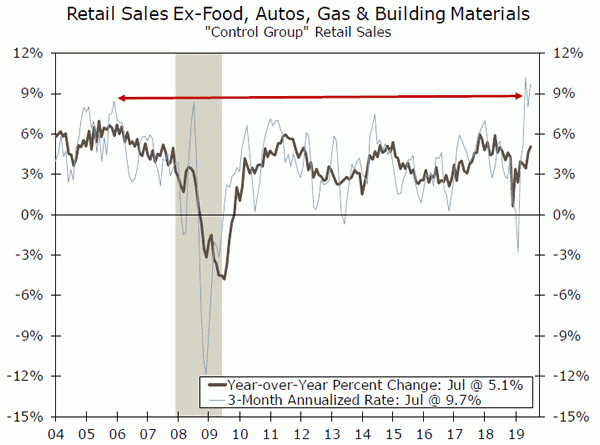
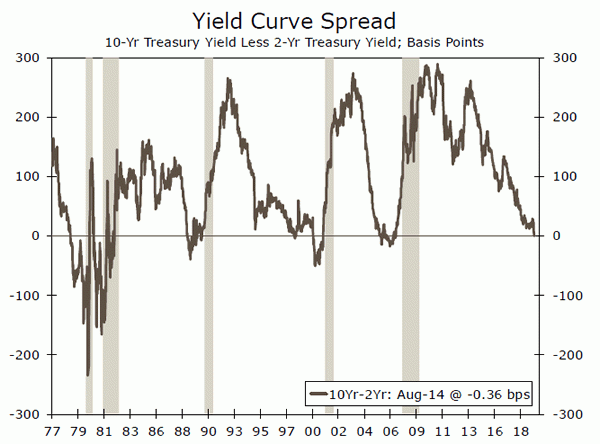
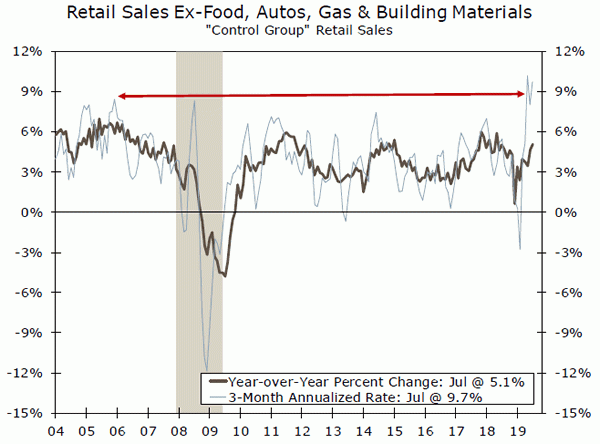
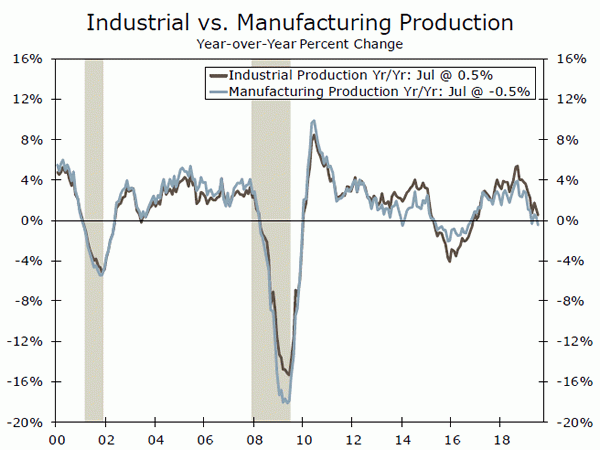
U.S. Outlook
Home Sales • Monday & Friday
Despite the plunge in mortgage rates, the housing market has struggled to gain momentum this year. Mortgage purchase applications have risen, though applications to refinance have seen a more pronounced jump recently, as home owners take advantage of lower rates. Refinancing accounted for about 60% of total applications in the week ending August 9. In Q2, mortgage debt held by households only just reached its prior peak in 2008, even as the economic expansion is now in its eleventh year. We expect low mortgage rates to translate into more buying activity and keep home sales on an upward trajectory, though low supply of affordable homes remains a key obstacle for the sector. The housing sector is a bit insulated from the trade war, but the NAR recently reported foreign purchasers have pulled back significantly over the past year, particularly Chinese buyers. Both existing and new home sales likely eked out small gain in July.
Previous: 5.27M & 646K Wells Fargo: 5.39M & 645K Consensus: 5.40M & 645K (Existing & New Home Sales)
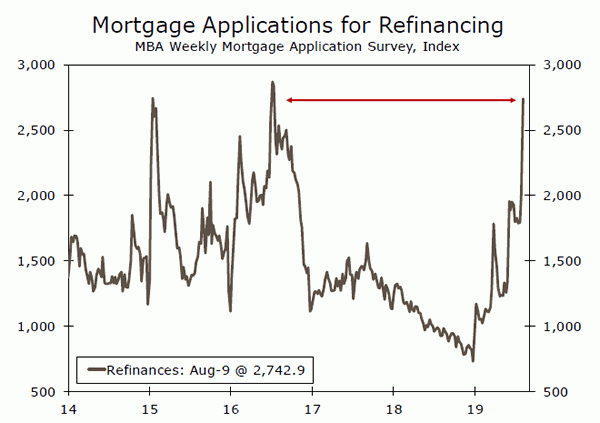
FOMC Meeting Minutes • Wednesday
On July 31, the Federal Open Market Committee (FOMC) cut the federal funds rate 25 bps to 2.00%-2.25%, and decided to end the reduction in its balance sheet in August. But, lower rates in the future are not necessarily preordained. Kansas City Fed President George and Boston Fed President Rosengren dissented from the rate cut decision, as voting members of the FOMC would have preferred to keep rates on hold. We suspect the minutes from the July policy meeting may disclose additional non-voting members who would have preferred no action as well. The Fed’s decision to cut rates in July was widely expected among analysts, but was likely contested among FOMC members. A tight labor market and below target inflation do not necessarily warrant rate cuts, causing the need for an “insurance” cut to be debatable. The minutes will provide further insight into the Fed’s decision and perhaps shine some light on how it may be interpreting the more recent economic turmoil.
We expect the Fed to cut rates 25 bps in September.
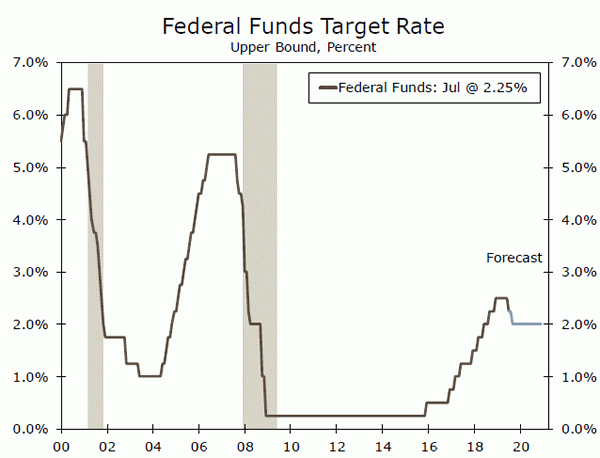
Leading Economic Index • Thursday
The leading economic index (LEI) groups together a number of key indicators that typically swing before the broader economy, making it a key leading barometer for economic growth. A quick glance at the chart to the right shows the index is undeniably losing momentum. The LEI has been more or less flat since September and declined 0.3% in June, which marks the first decline this year and the largest monthly drop since the start of 2016. With recent concern of an impending downturn the LEI is a key indicator to watch. Next week the Conference Board reports results for July, when equity markets soared to all-time highs and consumer expectations remained broadly positive. As such, we expect the LEI to rise 0.3%. The more recent market turmoil and intensified fears of recession will undoubtedly make their way into future readings of the LEI. But, we would need to see consecutive monthly declines before we label the recent moderation as a more pronounced slowdown.
Previous: -0.3% Wells Fargo: 0.3% Consensus: 0.2% (Month-over-Month)
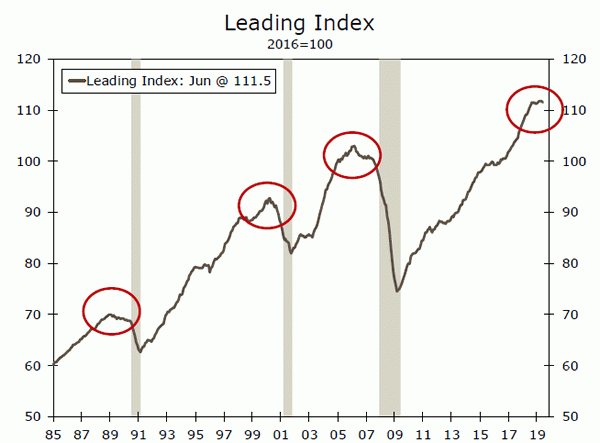
Global Review
Renewed Fears of a Prolonged Trade War
- Trade tensions between the U.S. and China remained a prominent theme in markets this week. Although the U.S. delayed tariffs on some imports from China until December, it may not be enough to stop Chinese retaliation.
- U.K. economic data released this week suggest the consumer sector has held up relatively well despite Brexit and political uncertainties hanging over the economy.
- Mexico’s central bank cut its key policy rate for the first time in over five years, noting increased global risks and expectations of further monetary policy easing by several other central banks.
The Latest from China
This week’s economic data gave the latest reading on the health of the Chinese economy. After a solid finish to the second quarter, the start of the third quarter looks less promising. July retail sales growth slowed more than forecast to 7.6% year-over-year, in part due to weakening auto sales. Meanwhile industrial production growth also slowed more than expected to 4.8% in July compared to a year earlier, marking the smallest increase since February 2002.
Also this week, China said the U.S. imposition of tariffs on an additional $300 billion of Chinese goods violated the consensus reached between presidents Trump and Xi, sparking renewed fears of a prolonged trade war. Although the United States delayed tariffs on some imports from China until December, it may not be enough to stop Chinese retaliation. The trade war is likely to further weigh on China’s economy with risks still to the downside. In the context of mixed survey data and persistent trade tensions, the data suggest further Chinese monetary policy easing is possible in the near term and reinforces the theme of an overall slowdown in Chinese growth. We expect China’s GDP growth to slow further to 6.1% and 5.8% in 2019 and 2020, respectively.
Mixed News from the United Kingdom
In the first half of 2019, U.K. economic data were relatively resilient amid Brexit uncertainties. The latest figures suggest growth in the industrial sector has softened, however the consumer sector has held up relatively well. CPI inflation edged higher in July with headline CPI rising 2.1% year-over-year, driven by an increase in the prices of clothing & shoes and recreation & culture. Core CPI also rose 1.9% year-over-year in July, up from 1.8% in June. Meanwhile, wages in the United Kingdom picked up 3.7% in the three months to June, reaching an eleven year high, while average annual pay excluding bonuses rose 3.9%.
While inflation is near the Bank of England’s target midpoint and consumer data remain solid, Brexit and political uncertainties still hang over the economy. In addition, global growth has eased significantly. Given the ongoing uncertainty, we expect the Bank of England to remain on hold for the remainder of this year and into next.
Central Bank of Mexico Cuts for First Time in Five Years
The Central Bank of Mexico opted to cut its policy rate 25 bps for the first time in over five years at its August meeting. In previous reports, we forecasted Mexico’s central bank would cut rates once in Q3-2019 and that the easing cycle would likely continue into 2020. Growth in Mexico has been disappointing with Q2 GDP growing at 0.1% quarter-over-quarter and the economy narrowly avoiding a technical recession. Inflation has also fallen in recent months, as oil prices declined, providing additional rationale for the central bank to cut. As growth and economic activity in Mexico continue to underperform, we maintain our view that the central bank will look to cut rates one more time in 2019. In its policy statement, it cited increased global risks—specifically the escalation of trade and political risks—and expectations of further monetary policy easing by several other central banks, which guided its monetary policy decision.
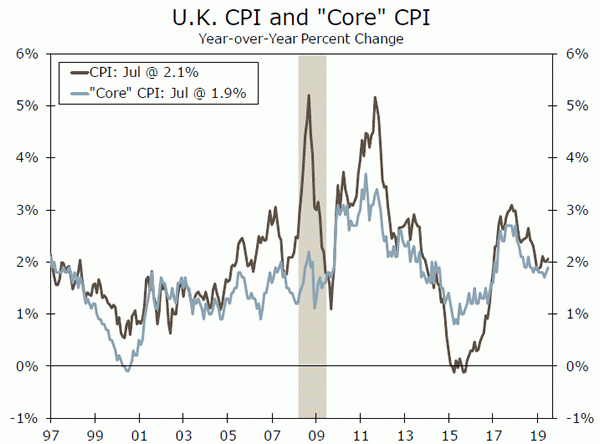
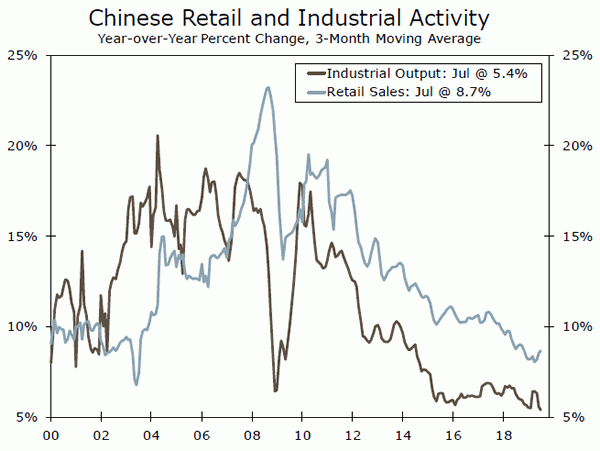
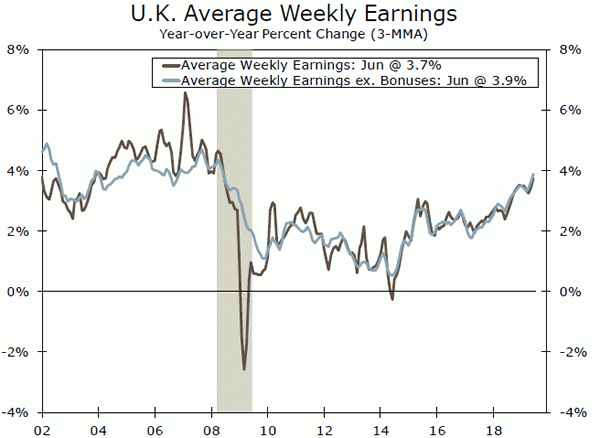
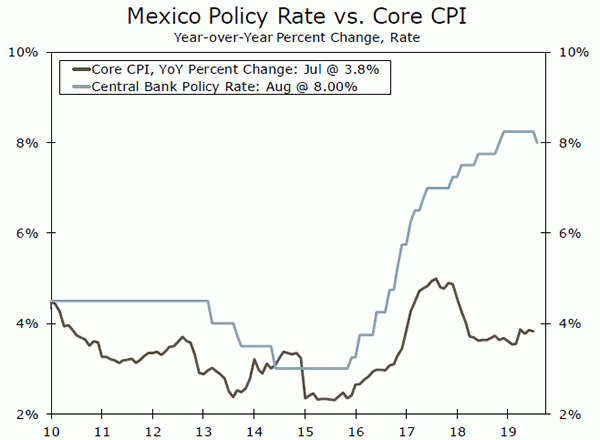
Global Outlook
Canada CPI • Wednesday
Canadian consumer inflation matched expectations in June with a slowdown to 2.0% year-over-year, down from 2.4% in May. Core inflation held steady in line with the Bank of Canada’s target, as well as consensus estimates. Lower oil and broader energy prices are likely to weigh on CPI in July, and we forecast headline CPI inflation to slow to 1.8% in 2019 and pick up slightly in 2020.
As for upside inflation risks, core inflation may show resilience in July after the latest average hourly earnings figure quickened and Canada’s economy grew for the third consecutive month in May, providing further evidence of a stronger Canadian economy. Even though Canadian job creation slowed in July, the labor market remains strong and provides an additional upside risk for inflation.
Previous: 2.0% Consensus: 1.6% (Year-over-Year)
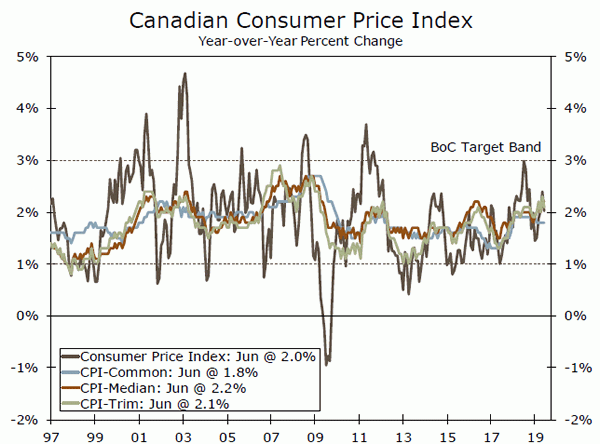
Eurozone PMIs • Thursday
Eurozone August PMIs are released next week after disappointing July figures. The July manufacturing PMI fell to 46.5, while the services PMI eased to 53.2. German manufacturing remains a source of weakness as that country’s manufacturing PMI fell to its lowest level in seven years, signaling a contraction. With subdued manufacturing and a relatively soft services sector, the Eurozone economy grew 0.2% quarter-over-quarter in Q2. In addition, June industrial output fell 1.6% month-over-month, providing a further indication that the Eurozone’s manufacturing sector remains fragile.
As of now, the service sector remains in expansionary territory, however the manufacturing sector is an increasing cause for concern. Softer than expected Eurozone data next week would keep the ECB on course to cut interest rates at its September meeting and restart its QE program, and perhaps influence the size of those moves.
Previous: 46.5 (Manufacturing), 53.2 (Services) Consensus: 46.5 (Manufacturing), 52.8 (Services)
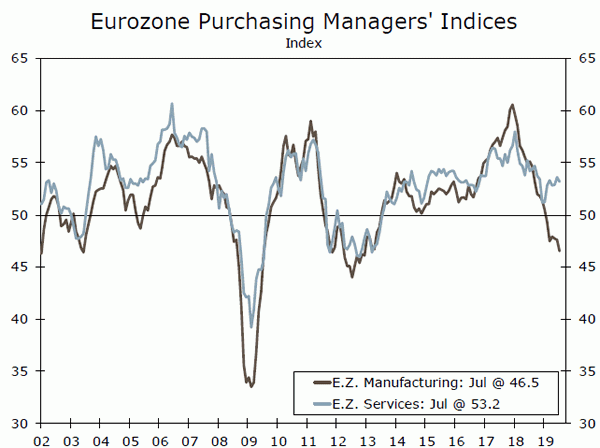
Mexico Economic Activity • Friday
Mexico’s economy has softened over the course of the year, as economic activity fell 0.4% year-over-year in May, the second straight decline. The June figures released next week could indicate whether the economy has started to recover and may provide some insight to how the economy will perform for the remainder of the year.
After the contraction in Q1 GDP, Mexico just barely dodged a technical recession in the first half of the year. The persistent slowdown in Mexico’s economy likely reflects relatively high interest rates set at 8.00%, while inflation is currently just below 4%. Amid ongoing global trade tensions and relatively weak Mexican economic data, we expect Mexico’s central bank to start to ease monetary policy in the near term, and another weak print on economic activity could provide further justification for rate cuts.
Previous: -0.4% (Year-over-Year)
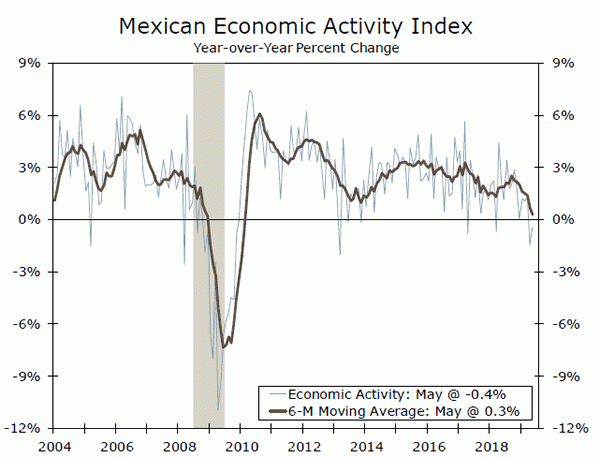
Point of View
Interest Rate Watch
Yield Curve Inverts
The market for U.S. Treasury securities has been in a frenzied rally since President Trump announced earlier this month that the United States would be imposing 10% tariffs on Chinese goods. The yield on the 30-year bond has plunged roughly 50 bps since late July and currently sits at an all-time low around 2.00%. The spread between the 2-year note and the 10-year note, which historically has been a reliable predictor of recession, sparked headlines this week when it briefly turned negative (top chart). Is recession imminent?
As we wrote in a report this week, the yield curve at present may not be quite as reliable as a recession predictor as it has been in the past. The purchases of Treasury securities that the Fed undertook as part of its quantitative easing (QE) program collapsed the term premium on long-dated Treasury securities (middle chart). The Fed is still holding over $2 trillion of Treasury securities on its balance sheet, so the yield on the 10-year note at present is arguably ¼ percentage point to maybe as much as ½ percentage point lower than it otherwise would be. In other words, the yield curve may not be inverted at present if not for the Fed’s QE purchases.
In our view, the underlying fundamentals of the economy are reasonably sound. The balance sheets of the household, nonfinancial and financial sectors are generally in good shape, and financial conditions are not overly restrictive. But there is plenty of uncertainty in the air. There are ongoing trade tensions between the United States and China, and the protests in Hong Kong could potentially lead to military intervention by China. The United Kingdom could crash out of the European Union on October 31.
Due, at least in part, to these uncertainties, we look for the Federal Open Market Committee (FOMC) to cut rates 25 bps at its next policy meeting on September 18 (bottom chart). Although we do not think that the underlying fundamentals justify further easing later this year, we readily acknowledge that the FOMC very well may opt for more “insurance” by cutting rates even further at its October and/or December policy meetings. Stay tuned.
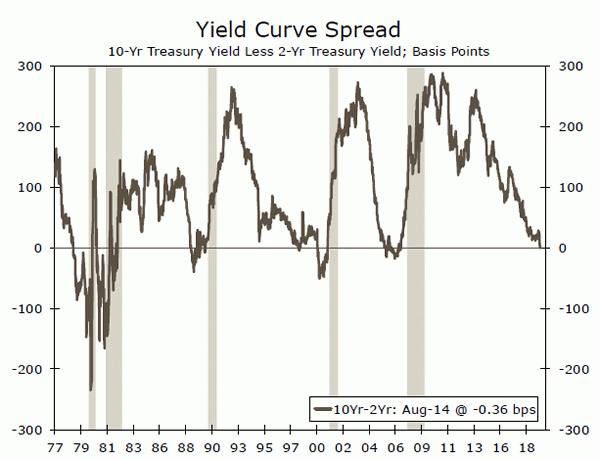
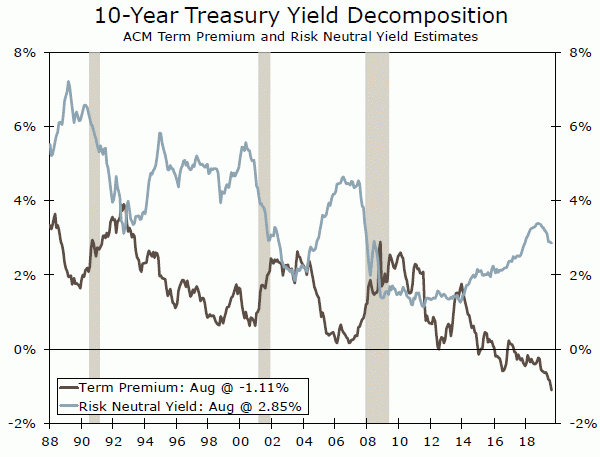
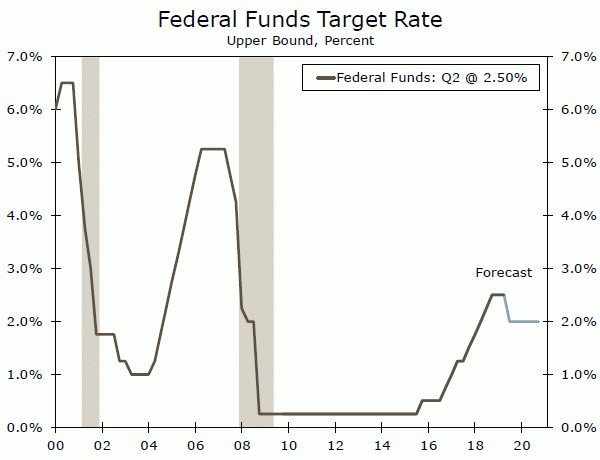
Credit Market Insights
Rates Recede, Refinancing Rises
Falling long term interest rates have rattled markets in recent weeks, though they have also been pushing homeowners to refinance. The refinancing index jumped 37% this week, while the four-month moving average is up 118% over the same period last year. This three-year high in the refinancing index comes as the average contract rate on a 30-year fixed rate mortgage dropped to 3.60%, the lowest since November 2016, according to the Freddie Mac Market Survey. This might suggest that the Fed’s attempt to ease financial conditions has begun to stimulate the nation’s housing market, but the majority of mortgage activity remains in the refinancing space, rather than purchases. Though refinancing does free up cash for consumers to deploy elsewhere.
Together, refinancing and purchases pushed mortgage originations up $130 billion in the second quarter to $470 billion. This coincided with an increase in total mortgage debt to $9.406 trillion, eclipsing the previous high set in the third quarter of 2008. While debt records can often grab headlines, it is important to remember that these particular figures are in nominal terms (i.e. not adjusted for inflation). Moreover, it is reasonable to expect these figures to increase over time in a healthy, growing economy. Furthermore, consumer credit quality in the mortgage market is still quite solid, especially compared to a decade ago. Foreclosures remain very low by historical standards and mortgage underwriting remains tight.
Topic of the Week
Tariff Update: “We’re Doing This for Christmas”
What’s Happening: The U.S. Trade Representative (USTR) announced on Tuesday that the 10% tariff on an approximate $300 billion ($262 billion by our calculations) of imports from China will go into effect on September 1, but stated that certain goods would not be subject to tariffs until December 15. Tariffs will be delayed on about 60% of the total, or roughly $155 billion, while the 10% tariff on the remaining $107 billion of imports will still go into effect on September 1.
Why It Matters: The delay reduces the risk that trade tensions will take a meaningful toll on consumer confidence and weaken household spending in the near term. But, we are talking about a delay in action rather than a truce. Consumer goods represent a bulk of the items in both installments of imports soon to be exposed to tariffs. The difference lies in the composition of consumer goods in the two installments. By our calculations, the bulk of the consumer portion exposed to tariffs in September is apparel, while electronic products make up a majority of the products delayed until December. Children’s toys are also not exposed until December. Any tariff related price increase on a new iPhone or TV will be delayed until after the holiday season.
Our Takeaway: We expect the tariffs to go into effect as the USTR laid out this week. This new round of tariffs will likely add about 0.1% to inflation. But, as retailers would likely be loath to raise prices ahead of the allimportant holiday season and many prices from their suppliers are already set, we do not expect to see tariffs from this tranche feed through to inflation until early next year. Once higher costs materialize, however, it will either lead to lower sales of the items exposed, or squeeze consumer wallet shares for other spending. It could also result in a lower saving rate, as consumers are only able to stretch a paycheck so far.
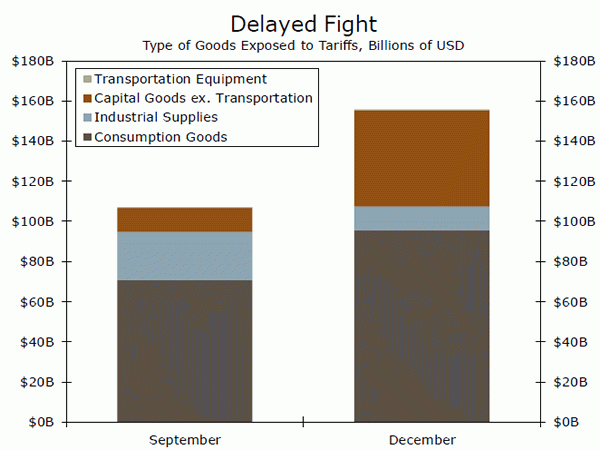
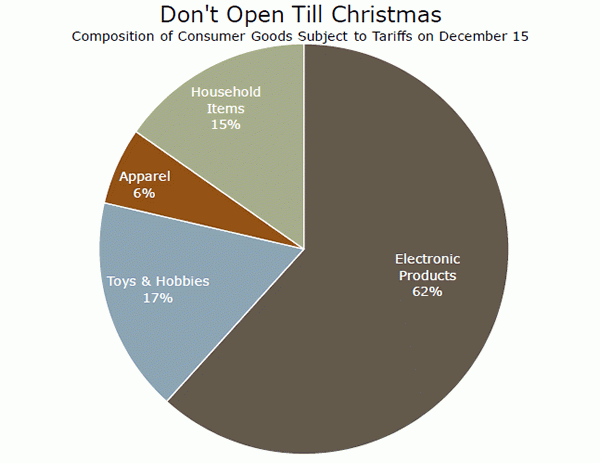


 Signal2forex.com - Best Forex robots and signals
Signal2forex.com - Best Forex robots and signals




